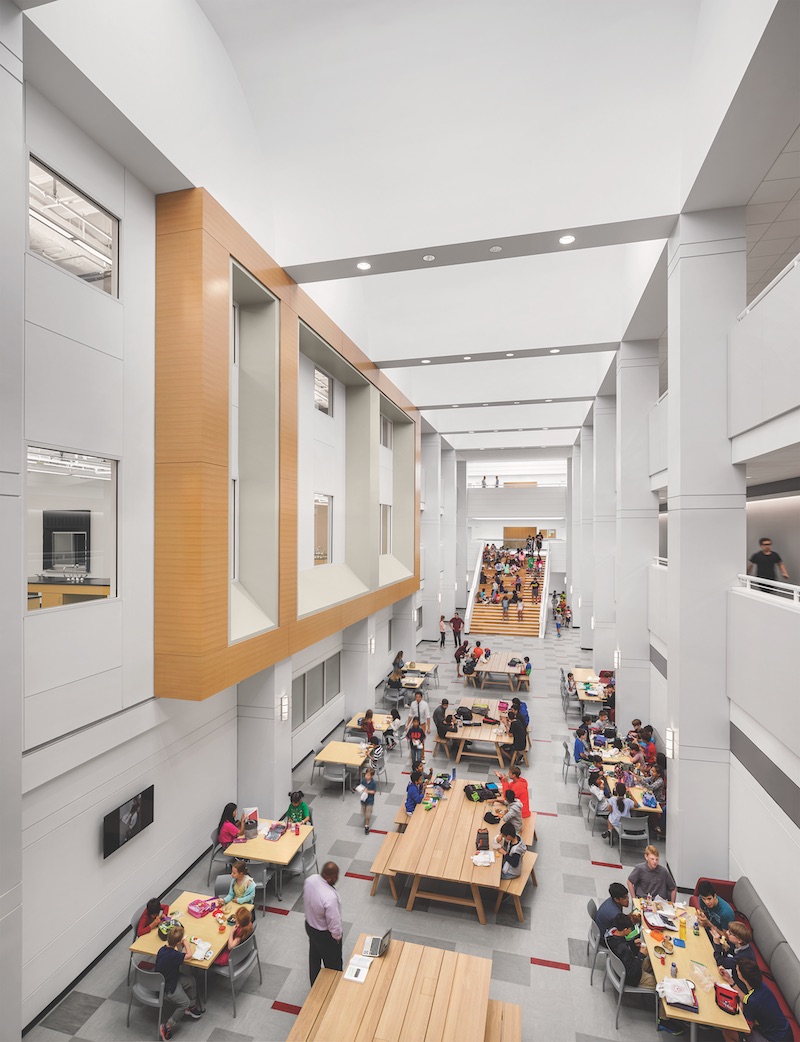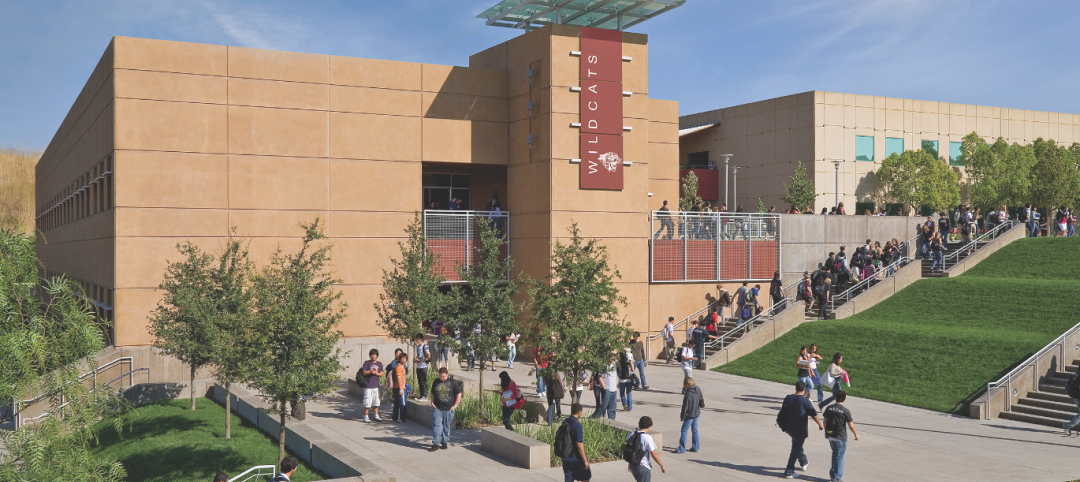The average age of the 84,000 public elementary and secondary schools in the U.S. is 44 years since construction, and 12 years since a major renovation, according to the Department of Education. School districts, say AEC experts, are more inclined than ever to tear down old schools and build new with the latest technological and security systems.
Older schools, with their small windows and rooms and creaky infrastructure, are tough and expensive to retrofit. That may explain why more school districts, when they choose to renovate, are preferring to adapt vacant buildings in their communities for reuse as modern schools.
And boy, are there a lot of vacant buildings out there. In the greater Washington, D.C., region alone, there’s over 70 million sf of unused office space. In Dallas, 30 million sf of offices sit empty, and 17 million sf in Phoenix. To say nothing of the hundreds of millions of retail square footage that e-commerce has rendered superfluous.
For example, last February, a former Kmart in Waukegan, Ill., became home to the 53,000-sf Cristo Rey St. Martin College Prep, an $18.5 million adaptive reuse project that JGMA designed and McShane Construction built, with 18 classrooms, three science labs, a cafeteria, library, and administrative offices for 400 students.
See Also: Making schools more secure is imperative, but how best to do that isn't settled yet
Adaptive reuse “is becoming a more established option for educational program space,” say the authors of a new white paper from Perkins Eastman, “Commercial Conversion: Adaptive Reuse, A Catalyst for Educational Innovation.” One reason is that schools are scrambling to keep pace with growing student populations. More than 31% of school sites include temporary buildings.
Culling from its own K-12 portfolio, Perkins Eastman provides case studies of creative adaptive reuse. In New York’s Chelsea neighborhood, Avenues: The World School of New York took a 215,000-sf, 1920s-era warehouse with 20,000-sf floor plates and converted it into a pre-K-12 school for 1,600 students. The building already had abundant windows on all four sides. But the classrooms had to be smaller than is typical because of the interior columns’ 20x20-foot spacing.
Other case studies—in New Jersey, Dallas, northern California, and northern Virginia—offer various adaptive scenarios, such as:
• a multitenant office tower where the school occupies the lower floors
• a former Verizon call center to which 30,000 sf was added over two floors for a private school for children and young adults with learning and behavioral disabilities
• a former corporate headquarters, whose deep, 120,000-sf floor plates are arranged around a series of atrium spaces, became the central organizing feature of a school.
In El Segundo, Calif., Balfour Beatty Construction Services recently completed the construction of a Gensler-designed project for the Wiseburn Unified School District and Da Vinci Schools, which converted a 330,000-sf former Northrup Grumman aerospace facility on 14 acres into three charter schools—collectively known as Wiseburn High School—on three floors with 72 classrooms and 210,000 sf above administrative offices.
David Herjeczki, AIA, LEED AP, a Design Director and Principal with Gensler, told the Daily Breeze newspaper that this $160 million project, which opened in December 2017 and serves 1,350 students, was the first of its kind to make it through the Division of State Architect approval process. The project came about after Wiseburn, a former K-8 district, won unification in 2014 and chose to partner with Da Vinci rather than build its own high school.
Herjecki explained that the idea was to build a nontraditional school whose learning environments reflect the professional world. Da Vinci Science, on the second floor, includes an engineering lab; Da Vinci Design, on the top floor, has a fabrication lab. Da Vinci Communications is located on the third floor.
Each of the three high schools has a retractable door that rolls up onto an outdoor patio. There are no corridors or lockers, and many of the walls are movable. The classrooms have rearrangeable desks, a science lab, and collaborative spaces. The building’s floor-to-ceiling windows offer transparency and views of the surrounding city.
A gym, soccer fields, and shared aquatics center were scheduled for completion this summer.
Related Stories
| Nov 29, 2010
New Design Concepts for Elementary and Secondary Schools
Hard hit by the economy, new construction in the K-12 sector has slowed considerably over the past year. Yet innovation has continued, along with renovations and expansions. Today, Building Teams are showing a keener focus on sustainable design, as well as ways to improve indoor environmental quality (IEQ), daylighting, and low-maintenance finishes such as flooring.
| Nov 23, 2010
Honeywell's School Energy and Environment Survey: 68% of districts delayed or eliminated improvements because of economy
Results of Honeywell's second annual “School Energy and Environment Survey” reveal that almost 90% of school leaders see a direct link between the quality and performance of school facilities, and student achievement. However, districts face several obstacles when it comes to keeping their buildings up to date and well maintained. For example, 68% of school districts have either delayed or eliminated building improvements in response to the economic downturn.
| Nov 9, 2010
Just how green is that college campus?
The College Sustainability Report Card 2011 evaluated colleges and universities in the U.S. and Canada with the 300 largest endowments—plus 22 others that asked to be included in the GreenReportCard.org study—on nine categories, including climate change, energy use, green building, and investment priorities. More than half (56%) earned a B or better, but 6% got a D. Can you guess which is the greenest of these: UC San Diego, Dickinson College, University of Calgary, and Dartmouth? Hint: The Red Devil has turned green.
| Nov 3, 2010
First of three green labs opens at Iowa State University
Designed by ZGF Architects, in association with OPN Architects, the Biorenewable Research Laboratory on the Ames campus of Iowa State University is the first of three projects completed as part of the school’s Biorenewables Complex. The 71,800-sf LEED Gold project is one of three wings that will make up the 210,000-sf complex.
| Nov 3, 2010
Park’s green education center a lesson in sustainability
The new Cantigny Outdoor Education Center, located within the 500-acre Cantigny Park in Wheaton, Ill., earned LEED Silver. Designed by DLA Architects, the 3,100-sf multipurpose center will serve patrons of the park’s golf courses, museums, and display garden, one of the largest such gardens in the Midwest.
| Nov 3, 2010
Seattle University’s expanded library trying for LEED Gold
Pfeiffer Partners Architects, in collaboration with Mithun Architects, programmed, planned, and designed the $55 million renovation and expansion of Lemieux Library and McGoldrick Learning Commons at Seattle University. The LEED-Gold-designed facility’s green features include daylighting, sustainable and recycled materials, and a rain garden.
| Nov 3, 2010
Recreation center targets student health, earns LEED Platinum
Not only is the student recreation center at the University of Arizona, Tucson, the hub of student life but its new 54,000-sf addition is also super-green, having recently attained LEED Platinum certification.
| Nov 3, 2010
Designs complete for new elementary school
SchenkelShultz has completed design of the new 101,270-sf elementary Highlands Elementary School, as well as designs for three existing buildings that will be renovated, in Kissimmee, Fla. The school will provide 48 classrooms for 920 students, a cafeteria, a media center, and a music/art suite with outdoor patio. Three facilities scheduled for renovations total 19,459 sf and include an eight-classroom building that will be used as an exceptional student education center, a older media center that will be used as a multipurpose building, and another building that will be reworked as a parent center, with two meeting rooms for community use. W.G. Mills/Ranger is serving as CM for the $15.1 million project.
| Nov 3, 2010
Virginia biofuel research center moving along
The Sustainable Energy Technology Center has broken ground in October on the Danville, Va., campus of the Institute for Advanced Learning and Research. The 25,000-sf facility will be used to develop enhanced bio-based fuels, and will house research laboratories, support labs, graduate student research space, and faculty offices. Rainwater harvesting, a vegetated roof, low-VOC and recycled materials, photovoltaic panels, high-efficiency plumbing fixtures and water-saving systems, and LED light fixtures will be deployed. Dewberry served as lead architect, with Lord Aeck & Sargent serving as laboratory designer and sustainability consultant. Perigon Engineering consulted on high-bay process labs. New Atlantic Contracting is building the facility.
| Nov 3, 2010
Dining center cooks up LEED Platinum rating
Students at Bowling Green State University in Ohio will be eating in a new LEED Platinum multiuse dining center next fall. The 30,000-sf McDonald Dining Center will have a 700-seat main dining room, a quick-service restaurant, retail space, and multiple areas for students to gather inside and out, including a fire pit and several patios—one of them on the rooftop.















